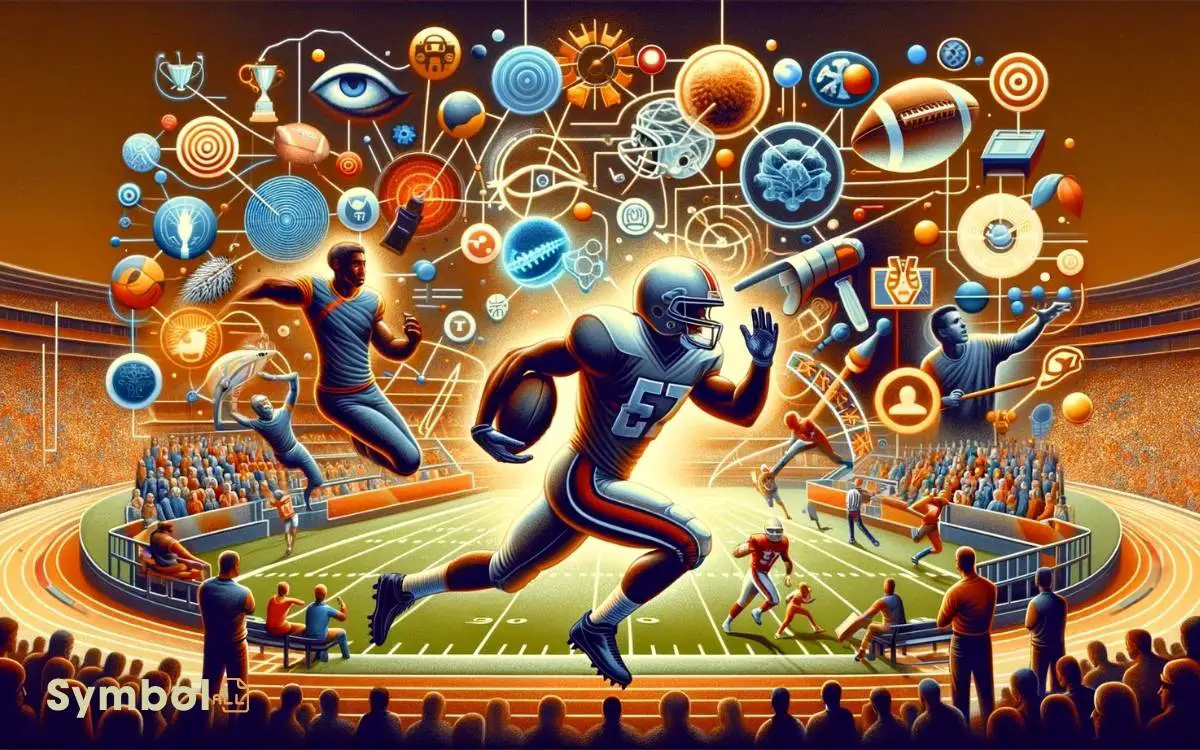Using the Symbolic Interaction Approach Sports Becomes
Through the symbolic interaction approach, you’ll see sports as a mirror of societal values and personal identities. Every chant, logo, or victory dance isn’t just for entertainment; it embodies community spirit, team ethos, and personal ambition.
You’re not just a fan or athlete; you’re an active player in shaping sports culture and societal norms. This perspective reveals how communication, both verbal and non-verbal, is key to team dynamics and individual performance.
Sports become a critical lens for examining social constructs, identity formation, and the impact of globalization. You’ll uncover more layers to this fascinating interplay, revealing the profound connection between society and sports.

Key Takeaways
Defining Symbolic Interactionism
Symbolic interactionism, at its core, posits that people create and interpret the social world through the meanings they assign to symbols, notably within the dynamic realm of sports.
You’re constantly engaging with these symbols, whether you’re celebrating a victory with a trophy or wearing your favorite athlete’s jersey. These aren’t just objects or actions; they embody deeply ingrained values, triumphs, and even defeats. They serve as powerful reminders of the stories and beliefs we hold dear, often transcending their physical form to represent something much greater. For instance, the fish symbol meaning in Christianity carries profound spiritual significance, representing faith, salvation, and the teachings of Jesus. Similarly, these symbols, regardless of their context, connect us to shared experiences and collective emotions that shape who we are.
This perspective illuminates how personal and collective identities are sculpted within sports culture. It’s not merely about the physicality or the competition; it’s the shared meanings that transform sports into a pivotal aspect of society.
Understanding this, you’ll see sports in a new light, appreciating not just the game, but the complex web of interactions and interpretations that give it life.
Sports as Social Constructs
Delving into the realm of sports reveals it as a complex social construct, shaped and reshaped by the collective interpretations and interactions of its participants.
You’re not just engaging in physical activity; you’re participating in a socially constructed arena where every rule, role, and ritual has been collectively agreed upon and perpetually evolves.
- Cultural Significance: Each sport carries unique cultural meanings and values.
- Roles and Identities: Athletes and fans adopt roles that reflect societal expectations.
- Rules and Norms: These are socially agreed upon and can change over time.
- Inclusion and Exclusion: Social constructs within sports can both unite and divide.
- Evolution: Sports evolve as societal attitudes and interactions change.
Understanding sports as social constructs allows you to see beyond the game, recognizing the intricate web of social interactions that define and transform it.
The Role of Communication
You’ll find that communication patterns in sports aren’t just about verbal exchanges; they’re the backbone of enhancing team dynamics.
Analyzing these patterns reveals how teams can improve performance and cohesion.
It’s crucial to understand the nuanced ways athletes and coaches interact, as these interactions significantly impact success.
Communication Patterns Explored
In exploring the realm of sports, understanding how communication patterns shape interactions reveals much about team dynamics and individual performance.
Communication isn’t just about what’s said out loud; it’s a complex interplay of verbal, non-verbal, and symbolic exchanges that can significantly impact a team’s success or an athlete’s performance.
- Non-verbal cues often convey more than words can, influencing teamwork and strategy.
- Conflict resolution strategies are crucial for maintaining harmony and focus.
- Feedback loops enable continuous improvement and adaptation.
- Motivational communication boosts morale and drives performance.
- Strategic silence can be powerful, allowing for reflection and self-motivation.
These patterns underscore the nuanced role communication plays in sports, beyond simple directives or cheerleading. They’re about creating a cohesive, adaptive, and high-performing team culture.
Enhancing Team Dynamics
Building on the understanding of communication patterns, let’s now explore how enhancing team dynamics through effective communication strategies can significantly impact performance in sports.
You’ve seen how communication molds interactions, but it’s crucial to recognize its power in forging stronger team bonds and unlocking potential.
Effective communication isn’t just about conveying strategies; it’s about understanding and empathy. When you actively listen and provide constructive feedback, you’re not just a teammate; you become a pillar of support.
This mutual respect and understanding foster a sense of belonging and significantly boost morale.
However, it’s critical to note that poor communication can have the opposite effect, breeding misunderstanding and conflict. Thus, mastering communication is essential for any team aiming for excellence.
Identity Formation in Athletes
Exploring the formation of identity among athletes reveals complex interactions between personal ambition, societal expectations, and the unique culture of sports.
You’re not just playing a game; you’re navigating a web of relationships and roles that significantly shape who you are and who you’ll become.
Consider these critical elements:
- Personal ambition drives your commitment and shapes your self-perception.
- Societal expectations influence your behavior and how you’re perceived by others.
- The culture of sports provides a framework for your identity, offering both constraints and opportunities.
- Success and failure in sports can profoundly affect your self-esteem and self-concept.
- Peer relationships within sports can reinforce or challenge your sense of self.
Understanding these dynamics is crucial for athletes aiming to balance their sports identity with their broader sense of self.
Fans and Shared Meanings
Moving beyond the individual athlete, it’s vital to examine how fans contribute to the creation of shared meanings within the realm of sports.
You see, fans aren’t just passive spectators; they’re active participants in constructing the narrative and significance of sports.
Through their cheers, attire, and social media discourse, fans collectively shape the culture and identity of teams and the sports themselves. This communal interaction fosters a sense of belonging and unity, transcending mere fandom to become part of a larger societal fabric.
However, it’s crucial to critically assess how this shared meaning can sometimes exclude or marginalize. The dynamics within fan communities can both empower and disenfranchise, highlighting the complex role fans play in the symbolic interaction within sports.
Symbols in Sports Culture
Symbols in sports culture, from team logos to victory dances, serve as powerful vessels of identity and unity, deeply influencing both individual and collective experiences within the sports domain.
These elements aren’t just decorative; they’re imbued with meaning and purpose, shaping perceptions and behaviors.
- Team Logos: More than mere designs, they symbolize a community’s spirit and history.
- Victory Dances: Celebratory rituals that foster team cohesion and fan connection.
- Uniform Colors: Convey values and traditions, uniting players and supporters.
- Mascots: Personify team ethos, engaging and rallying fans.
- Chants and Songs: Amplify collective identity, transforming spectators into an active part of the game.
Understanding these symbols unravels the complex fabric of sports culture, revealing how deeply sports are woven into the social fabric.
Interaction Among Team Members
While symbolic elements like team logos and victory dances unite players and fans, it’s the interactions among team members themselves that truly forge the heart of a sports team’s culture and success.
You see, the way athletes communicate, support, and challenge each other during practices, games, and off-field activities significantly impacts their collective performance and morale.
These interactions aren’t just about strategy or physical prowess; they’re also about building trust, understanding, and a shared sense of purpose.
Critical to this process is the role of leaders within the team who facilitate open dialogue, mediate conflicts, and exemplify the values the team stands for.
Without these nuanced, ongoing interactions, a team’s potential is merely theoretical, never fully realized in the heat of competition.
The Spectacle of Competition
In the world of sports, competition transforms into a captivating spectacle, where every play, decision, and moment carries weight beyond the immediate outcome.
You’re drawn into a narrative where athletes aren’t just competitors; they’re protagonists in their own right, each action contributing to the unfolding drama.
- Intensity of Rivalries: Elevates contests to legendary status.
- Athlete’s Dedication: Reflects the personal sacrifices and relentless pursuit of excellence.
- Fan Engagement: Creates a communal atmosphere, uniting strangers.
- Historic Moments: Each game can birth an unforgettable event.
- Symbolic Meaning: Competitions often transcend sport, symbolizing broader cultural or national narratives.
These elements combine, making sports more than just games. They become platforms for storytelling, where the spectacle of competition provides a mirror to society’s values, challenges, and aspirations.
Media Influence on Perception
You must recognize how media molds athletic identities, often distorting the true essence of sportsmanship through selective highlight reels.
This not only skews your perception but also pressures athletes into fitting a narrated persona, sidelining their genuine attributes.
Such portrayal questions the authenticity of sports narratives, urging a critical examination of media’s role in shaping our understanding of athletic excellence.
Shaping Athletic Identities
Media’s portrayal of athletes significantly shapes public perception, molding societal expectations of athletic identities. Through various platforms, the media crafts narratives that influence how athletes are seen and, consequently, how they see themselves.
This dynamic interaction can profoundly affect an athlete’s personal and professional life, underlining the importance of critical media consumption.
- Stereotyping: Athletes are often boxed into narrow stereotypes, limiting public understanding of their full identities.
- Role Modeling: Young viewers internalize media portrayals, shaping their aspirations and self-concepts.
- Pressure: Intense media scrutiny can place undue pressure on athletes, impacting mental health.
- Branding: Athletes’ identities are commodified, influencing their marketability and career opportunities.
- Authenticity: Media narratives can overshadow athletes’ true selves, creating a gap between public persona and private reality.
Analyzing these aspects reveals the intricate ways media influence molds athletic identities, urging a more nuanced consumption and portrayal.
Highlight Reel Impact
Highlight reels, by distilling athletes’ performances into their most spectacular moments, profoundly shape your perception of sports excellence and achievement.
These carefully curated clips don’t just entertain; they set a high bar for what you consider extraordinary, overshadowing the day-to-day dedication and the less glamorous aspects of athletic pursuit.
You’re nudged to value peak moments over consistent effort, potentially skewing your understanding of what true sportsmanship involves.
This selective portrayal can distort your appreciation of an athlete’s overall contribution to their sport, reducing a career to a series of highlights.
It’s critical to recognize this media influence and seek a more balanced view that appreciates the less visible, yet equally significant, dimensions of athletic achievement.
Rituals and Traditions
Rituals and traditions in sports serve as vital threads that weave the fabric of team identity and cohesion, shaping the social dynamics within and beyond the game.
These practices aren’t just for show; they’re key to building a shared identity and instilling a sense of pride and belonging among team members and fans alike.
- Pre-game rituals enhance focus and team unity.
- Victory celebrations reinforce success and communal achievement.
- Mourning losses together helps in coping and resilience building.
- Seasonal traditions mark time and progress, embedding the sport in broader cultural practices.
- Passing rituals onto new members fosters continuity and a deepened sense of belonging.
Analyzing these elements critically, we recognize how rituals and traditions in sports aren’t mere formalities but pivotal in constructing and maintaining the social fabric of teams and their communities.
Gender Roles and Stereotypes
Gender roles and stereotypes in sports often serve as invisible barriers that subtly dictate who should participate and how they’re perceived within the athletic domain.
You’ve likely observed how these stereotypes frame men as inherently more suited for physically demanding sports, while women are often nudged towards activities deemed less aggressive. This not only limits individual potential but also reinforces a narrow view of gender capabilities.
It’s crucial to recognize how these stereotypes impact young athletes’ aspirations and self-esteem.
By critically examining and challenging these preconceived notions, you contribute to creating a more inclusive sporting environment. Remember, sports should celebrate and nurture talent irrespective of gender.
Breaking down these barriers opens up a world where every athlete’s ability is the only measure that truly matters.
Race and Representation
In exploring the realm of sports, it’s crucial to acknowledge how racial representation shapes both opportunities and perceptions for athletes of diverse backgrounds.
This dynamic influences not just individual careers but also the broader societal narratives around race and athleticism.
- Racial stereotypes often limit the types of sports athletes from minority groups are expected to excel in.
- Media portrayal can reinforce or challenge these stereotypes, impacting public perception.
- Access to resources and opportunities in sports can be racially skewed, favoring certain demographics.
- Historical exclusion of racial groups from certain sports leagues has long-lasting effects on representation.
- Efforts towards inclusivity and diversity in sports can significantly alter racial dynamics, providing a more equitable platform for all athletes.
Understanding these facets offers a critical lens through which to view the interplay between race and sports, urging a push towards greater inclusivity and fairness.
The Economic Impact
While exploring the intersection of sports and economics, it’s crucial to recognize how the financial contributions of athletics extend far beyond ticket sales and merchandise, shaping communities and influencing broader economic trends.
| Factor | Impact |
|---|---|
| Local Businesses | Boost in revenue due to event-driven foot traffic |
| Employment | Creation of jobs in sectors directly and indirectly related to sports |
| Infrastructure | Investments in stadiums and facilities stimulate local economies |
| Tourism | Increased visitor spending on hotels, dining, and entertainment |
| City Branding | Enhanced global recognition and attractiveness for future investments |
You’ll notice that sports aren’t just games; they’re powerful economic engines driving significant impacts across various sectors. This reality invites a deeper analysis of sports’ role in economic development, encouraging stakeholders to strategize for holistic community benefits.
Globalization of Sports
Shifting focus to the globalization of sports, it’s evident that this phenomenon has significantly reshaped the landscape of international athletics, fostering a global community centered around shared passions and competitive spirit.
This transformation isn’t just about more widespread broadcasts or international competitions; it digs deeper, influencing cultural exchanges, economic policies, and even the identity of sports themselves.
- Widespread access to international competitions has democratized viewership, breaking down geographical barriers.
- Athletes often become cultural ambassadors, promoting cross-cultural understanding and diplomacy.
- The commercialization of sports on a global scale has intensified, affecting local economies and global markets.
- Sports governance has had to adapt, leading to more inclusive, globally recognized policies and regulations.
- The rise of e-sports and digital platforms has accelerated globalization, creating an interconnected community of gamers and fans.
Future Directions in Research
You must recognize that expanding the theoretical framework within the symbolic interaction approach in sports is critical.
By integrating methodological innovations, you’ll pave the way for more nuanced and comprehensive analyses.
Additionally, exploring interdisciplinary collaboration opportunities can significantly enrich the depth and breadth of your research.
Theoretical Framework Extensions
Exploring the symbolic interaction approach in sports opens numerous avenues for future research, necessitating a critical examination of its theoretical framework extensions to understand the nuanced interactions between individuals and their social worlds.
As you delve deeper into this field, consider the following key areas for expansion:
- Integration of digital and social media dynamics
- Analysis of non-verbal communication cues in sports
- Cross-cultural comparisons of sports interactions
- The role of identity and self-concept in athlete performance
- Influence of societal changes on sports symbolism
These focal points offer a roadmap for dissecting the complex web of meanings, symbols, and interactions in sports. By critically engaging with these extensions, you’re poised to uncover richer, more profound insights into the social fabric of sports.
Methodological Innovations Needed
To fully grasp the potential of the symbolic interaction approach in sports, researchers must innovate methodologically, transcending traditional boundaries to capture the essence of social interactions.
This demands a move beyond mere observation and into immersive, interactive research methods.
You’ll need to leverage advanced technologies like virtual reality to simulate sports environments and experiment with social dynamics in controlled, yet realistic settings.
Ethnographic approaches, where you embed yourself within teams or fan communities, become crucial. They provide nuanced insights into the symbols and meanings crafted in these spaces.
However, this calls for critical reflexivity to navigate biases and power dynamics. It’s not just about collecting data; it’s about engaging deeply with the context and understanding the fluidity of social interactions in sports settings.
This shift challenges you to think creatively and ethically about your research practices.
Interdisciplinary Collaboration Opportunities
Harnessing the symbolic interaction approach in sports research opens vast interdisciplinary collaboration opportunities, notably with fields like sociology, psychology, and data science, to deepen our understanding of social dynamics.
- Sociology can unravel the societal structures influencing sports interactions.
- Psychology offers insights into the cognitive processes behind athletes’ and fans’ behaviors.
- Data Science enables the quantification and analysis of complex interactions at scale.
- Cultural Studies examine how sports shape and are shaped by cultural identities.
- Educational Sciences provide perspectives on learning through sports and physical activities.
Conclusion
You’ve ventured deep into the realm where sports transcend mere games, becoming a universe woven from symbols and interactions.
Through the lens of symbolic interactionism, every pass, goal, and cheer isn’t just part of the game; it’s a thread in the social fabric that shapes identities, carves communities, and even dictates economies.
As you stand on this precipice, staring into the future, remember: sports aren’t just life; they’re a larger-than-life canvas, daring us to decipher its meanings and predict its next colossal transformation.





